Astronomical unit - Study guides, Class notes & Summaries
Looking for the best study guides, study notes and summaries about Astronomical unit? On this page you'll find 238 study documents about Astronomical unit.
Page 3 out of 238 results
Sort by

-
AST 111 Exam Ch. 1-3 || very Flawless.
- Exam (elaborations) • 7 pages • 2024
- Available in package deal
-
 FullyFocus
FullyFocus
-
- $10.99
- + learn more
Put the following into perspective: the size of our solar system; the distance to nearby stars; the size of the Milky Way Galaxy; the size of the observable universe. Rank from largest to smallest. To rank items as equivalent, overlap them. correct answers The observable universe, The Milky Way Galaxy, Distances to nearby stars, and The Solar system Light-year: correct answers The distance that light travels in 1 year, which is about 9.46 trillion kilometers. Astronomical Unit: correct an...

-
AST111 FALL ASU EXAM 1 study guide || A+ Graded Already.
- Exam (elaborations) • 9 pages • 2024
-
 FullyFocus
FullyFocus
-
- $10.99
- + learn more
FIELD OF VIEW correct answers The area visible in an image. Usually given as the diameter of the region. HOW LARGE IS THE FIELD OF VIEW? correct answers 1 mile wide or 1.6 km wide WHAT TYPE OF SYSTEM DO ALL SCIENTISTS USE TO MEASURE SIZES? correct answers The metric system. What is the SI unit of force? correct answers The newton named after Isaac newton What is the SI unit of energy? correct answers Joule (J) How is density expressed in Si units? correct answers Kilograms per cub...
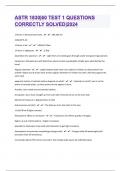
-
ASTR 1830|60 TEST 1 QUESTIONS CORRECTLY SOLVED|2024
- Exam (elaborations) • 8 pages • 2024
-
 jackline98
jackline98
-
- $7.99
- + learn more
1 Parsec in Astronomical Units - ️️206 265 AU 2.06x10^5 AU 1 Parsec in km - ️️3.09x10^13km 1 Parsec in Lightyears - ️️3.26ly absorbtion line spectrum - ️️Light from a hot body goes through cooler transparent gas (prism); Viewed as a full spectrum with black lines where certain wavelengths of light were absorbed by the cloud Angular diameter - ️️angle between both ends of an object in relation to observation from another object (sun & moon have similar angular diameters ...

-
practice post test #2 | Questions and Correct Answers | Latest Update 2024/2025 | 100% PASS
- Exam (elaborations) • 27 pages • 2024
- Available in package deal
-
 mercylynneh
mercylynneh
-
- $11.99
- + learn more
practice post test #2 | Questions and Correct Answers | Latest Update 2024/2025 | 100% PASS Select the correct answer from each drop-down menu. The distance between Earth and Mars is 225 million km. When converted using the conversion factor 1 AU = 1.5 × 108 km, the distance between the planets is [0.2 AU/1.5 AU/2.0 AU]. The astronomical unit (AU) is [shorter than/longer than/the same as] a light-year. - Answer - 1.5 AU SHORTER THAN Drag each tile to the correct location. A scientist...
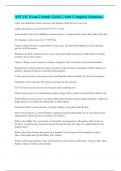
-
AST 111 Exam 2 Study Guide || with Complete Solutions.
- Exam (elaborations) • 13 pages • 2024
- Available in package deal
-
 FullyFocus
FullyFocus
-
- $11.49
- + learn more
Light year definition correct answers The distance light travels in one year Light year distance correct answers 9.5*10^12 km Astronomical Unit (AU) definition correct answers Average distance from the Earth to the Sun AU distance correct answers 1.5*10^8 km Galaxy correct answers A great cloud of stars, gas, and dust held together by the combined gravity of all its matter Planetary Systems correct answers A set of gravitationally bound non-stellar objects in orbit around a star o...
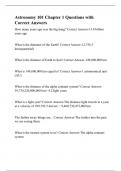
-
Astronomy 101 Chapter 1 Questions with Correct Answers
- Exam (elaborations) • 5 pages • 2024
-
cracker
-
- $17.49
- + learn more
How many years ago was the big bang? Correct Answer-13.8 billion years ago What is the diameter of the Earth? Correct Answer-12,756.3 km(equatorial) What is the distance of Earth to Sun? Correct Answer-149,600,000 km What is 149,600,000 km equal to? Correct Answer-1 astronomical unit (AU) What is the distance of the alpha centauri system? Correct Answer-39,734,220,000,000 km= 4.2 light years What is a light year? Correct Answer-The distance light travels in a year at a velocity of...
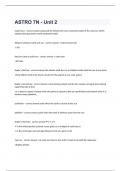
-
ASTRO 7N - Unit 2 questions with answers 2024/2025
- Exam (elaborations) • 14 pages • 2024
- Available in package deal
-
 7Eleven
7Eleven
-
- $13.99
- + learn more
ASTRO 7N - Unit 2Copernicus - correct answer proposed the heliocentric (sun-centered) model of the universe, which replaced the geocentric (earth-centered) model distance between earth and sun - correct answer 1 astronomical unit -1 AU time for earth to orbit sun - correct answer 1 earth year -365 days Kepler's first law - correct answer the planets orbit the sun in elliptical orbits with the sun at one focus -these ellipses tend to be nearly circular for the planets in our solar s...

-
AST 111 Test 1 || A+ Guaranteed.
- Exam (elaborations) • 4 pages • 2024
- Available in package deal
-
 FullyFocus
FullyFocus
-
- $10.79
- + learn more
Scientific notation is used in astronomy to correct answers Conventionally express numbers with lots of zeros The distance 1000 AU is expressed in scientific notation as correct answers 10^3 The distance of one "Astronomical Unit", or AU, is defined as correct answers The average distance from the Earth to the sun How many official constellations were established by the International Astronomical Unit? correct answers None of the above. (88) Groupings of stars less formally defined...
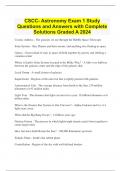
-
CSCC- Astronomy Exam 1 Study Questions and Answers with Complete Solutions Graded A 2024
- Exam (elaborations) • 15 pages • 2024
-
 PossibleA
PossibleA
-
- $14.99
- + learn more
Cosmic Address - The galaxies we see through the Hubble Space Telescope Solar System - Sun, Planets and their moons, and anything else floating in space Galaxy - Great island of stars in space all held together by gravity and orbiting a common center Where is Earth's Solar System Located in the Milky Way? - A little over halfway between the galactic center and the edge of the galactic disk Local Group - A small cluster of galaxies Supercluster - Regions of the universe that is ti...

-
BIL 150 - Van Dyken (Exam 1) A+ GRADED SOLUTIONS.
- Exam (elaborations) • 8 pages • 2024
- Available in package deal
-
 ProPerfomer
ProPerfomer
-
- $11.39
- + learn more
What are the 7 characteristics of life? correct answers 1. Contains Macros 2. Composed of cells 3. Reproduces 4. Use energy/raw materials 5. Respond to stimuli 6. Homeostasis 7. Adaptation/Evolution What does structure determine? correct answers structure determines function What are the 5 unifying themes of biology? correct answers 1. Organization 2. Information 3. Energy 4. Interactions 5. Evolution What are the levels of biology? correct answers atoms, molecules, organelles...

Study stress? For sellers on Stuvia, these are actually golden times. KA-CHING! Earn from your study resources too and start uploading now. Discover all about earning on Stuvia


